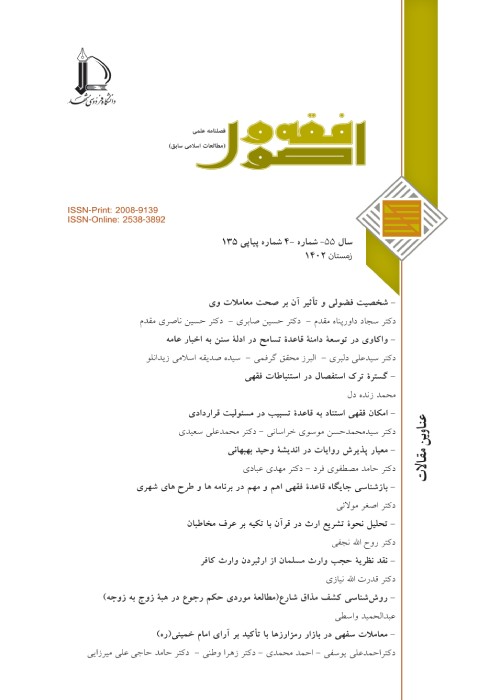An introduction into the impediment removal rule (the return of prohibition in case of impediment removal)
Author(s):
Abstract:
One of the most widely used rules of jurisprudence is ‘impediment removal’ often expressed by the phrase ‘when impediment is removed, the forbidden is regained.’ The application of this rule in jurisprudential matters produces important outcomes since impediment in those matters can prevent the penetration (validity) of the primary ruling, and as a result, the secondary ruling would be issued and actualized. The application of the impediment removal rule in this context would imply that if a mandated or assigned (obligatory) ruling becomes invalid due to the existence of an impediment, after the removal of that impediment the secondary ruling becomes unenforceable and the primary ruling must be enforced again on the responsible agent. Unfortunately, despite its many applications which fall within the provisions of secondary and governmental (state) rules, and in spite of numerous references to it in books of jurisprudence, this rule has not been independently investigated and its limits and conditions or the conditions of its authority have not been dealt with. Therefore, we witness much improper application of the rule in relating literature. Hence, to clarify the various dimensions of the issue, and through the application of a descriptive-analytical method and a data collection from library resources and documentations, first an accurate and comprehensive definition of the term ‘impediment’ is provided. Then, its difference with similar terms including disclaimer (rāfi’), certain (qāti’), and excuse (‘odhr). In addition, the rule has been compared with similar or related principles such as ‘Necessities make prohibitions permissible’, ‘A necessity is considered by its own measure’, ‘What is permissible due to an excuse becomes prohibited after its removal’, and ‘What is removed does not return.’ After an analysis of the argumentations for the rule (e.g. revision of the criterion and removal of specifications, rational reason and rationalist conduct) and with regard to the application and nature of the rule, nine conditions are drawn for its implementation or authority.
Language:
Persian
Published:
Islamic Jurisprudence & Its Principles, Volume:47 Issue: 101, 2015
Pages:
159 to 181
magiran.com/p1465485
دانلود و مطالعه متن این مقاله با یکی از روشهای زیر امکان پذیر است:
اشتراک شخصی
با عضویت و پرداخت آنلاین حق اشتراک یکساله به مبلغ 1,390,000ريال میتوانید 70 عنوان مطلب دانلود کنید!
اشتراک سازمانی
به کتابخانه دانشگاه یا محل کار خود پیشنهاد کنید تا اشتراک سازمانی این پایگاه را برای دسترسی نامحدود همه کاربران به متن مطالب تهیه نمایند!
توجه!
- حق عضویت دریافتی صرف حمایت از نشریات عضو و نگهداری، تکمیل و توسعه مگیران میشود.
- پرداخت حق اشتراک و دانلود مقالات اجازه بازنشر آن در سایر رسانههای چاپی و دیجیتال را به کاربر نمیدهد.
In order to view content subscription is required
Personal subscription
Subscribe magiran.com for 70 € euros via PayPal and download 70 articles during a year.
Organization subscription
Please contact us to subscribe your university or library for unlimited access!



